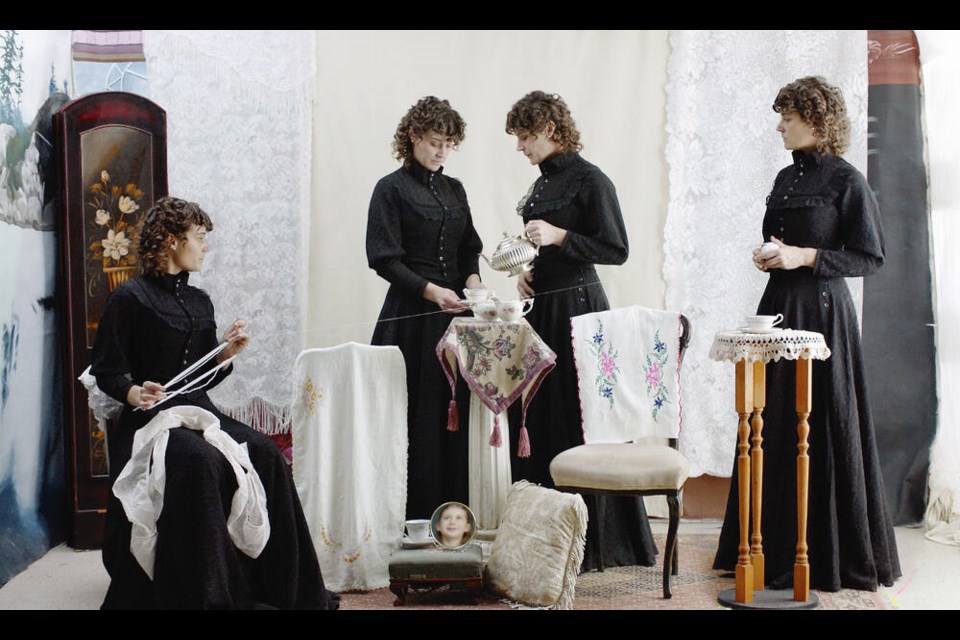BE STILL
Where: Cinecenta, University of Victoria, 3800 Finnerty Rd.
When: Tuesday, Jan. 16, 5 p.m. and 7:30 p.m.
Tickets: $7
When filmmaker Elizabeth Lazebnik decided to write and direct a dramatic feature film about the life of Victoria surrealist photographer Hannah Maynard, she knew Be Still would be moving cinema. Harrowing, even.
Lazebnik used a 2001 play about Maynard by Victoria playwright Janet Munsil for narrative purposes, and let the stories behind her groundbreaking wet-plate images, which earned Maynard a reputation as one of the world’s first surrealist photographers, take care of the rest.
“I wasn’t trying to make it experimental for the sake of it,” Lazebnik said of the sepia-toned film. “I know it’s not an easy watch, but it’s good to see it on the big screen because with the images and sound you get to see her process.”
Lazebnik, who lives in Toronto, completed Be Still nearly three years ago. The film had its world première at the 2021 Vancouver International Film Festival, which resulted in a trio of Vancouver Film Critics Circle nominations and three Leo Award wins, including ones for costume design and production design.
Be Still (which stars Piercey Dalton as Maynard) will be screened in Victoria for the first time tonight, where Maynard lived from 1862 until her death in 1918. Lazebnik will be on hand for question-and-answer sessions following the 5 p.m. and 7:30 p.m. screenings at Cinecenta. Five of Maynard’s photographs, culled from the B.C. Archives, will be on display as well.
The stark imagery of these large-scale prints will add a compelling subtext to Be Still, Lazebnik said. The haunting, almost macabre nature of some of Maynard’s work — her multiple-exposure imagery, specifically — is what caught Lazebnik’s eye for the first time decades ago.
“There is definitely surrealism, but also some meaning abut life and death,” said Lazebnik, who also made a short film about the photographer, The Multiple Selves of Hannah Maynard, in 2005. “There’s humour in there, too. A cheekiness to it.”
Maynard’s studio operated in downtown Victoria for several decades, remaining a hub of activity until its closure in 1912 (she was also known for her portraiture work with the Victoria Police Department.) The photographer remains a curiosity to some in the modern era, however.
“Not many know her work,” Lazebnik said. “People will still find it interesting if they are into photography or B.C. history, but most people don’t know about her.”
Reenactments of her photos can be seen in the film, including ones of Maynard’s 16-year-old daughter, Lillian, who died of typhoid fever in 1883. Mental illness brought about by the death is explored, if not overtly implied. “I don’t know if Hannah was autistic, but she definitely had an obsessiveness to her,” Lazebnik said.
That side of Maynard was evident in her Gems of B.C. series, according to Lazebnik. Maynard created the series of photomontages between 1881 and 1895, and sent them as a greeting card to mothers of the children she had photographed.
“One of the collages I believe had the faces of 22,000 children in it,” Lazebnik said. That’s really hard, meticulous, and obsessive work.”
Following the completion of Be Still, Lazebnik says she was diagnosed with Asperger’s Syndrome (now called Autism Spectrum Disorder). After two films on the subject and many years studying Maynard, she said the news put her “special interest” in Maynard into perspective. “That’s partly why I think I was interested in her. Non-linear, interesting visuals, and surrealism, these are all my obsessions.”
Around the time Lazebnik made her first film about Maynard, The Multiple Selves of Hannah Maynard, the director had not been diagnosed with autism. But during the making of Be Still, she learned more about her condition, deciding to keep it private until the film had been released.
“There is nothing to be ashamed about. It’s a part of me. It makes my neurodivergent brain work a little differently, but it brings interesting perspectives.”



